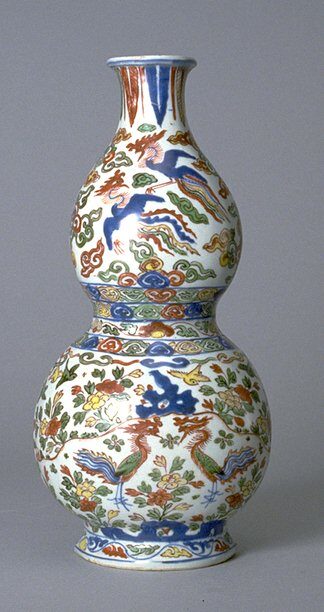Double-Gourd Wall Vase
Chinese

Description
Gallery Rotation Summer 2013
5. Double-gourd wall vase with phoenix design
China, Jiangxi province, Jingdezhen, Ming dynasty, 1368–1644,Wanli mark and period
1573–1620
Porcelain with underglaze cobalt blue and overglaze enamel decoration
Gift of Marian Doering in memory of Paul M. Doering, 1979/2.12
6. Double-gourd wall vase with dragon design
China, Jiangxi province, Jingdezhen, Ming dynasty, 1368–1644,Wanli mark and period
1573–1620
Porcelain with underglaze cobalt blue decoration
The Margaret Watson Parker Art Collection Fund, 1986/2.13
The Chinese dragon, a benevolent animal that exhales clouds and fire, symbolizes the emperor and heaven. The Yin counterpart to the Yang dragon is the phoenix, which presides over the southern area of the heavens and represents the sun, warmth, and summer. The phoenix is the emblem of the empress. The double gourd or calabash is a symbol of the unity between heaven and earth. Both of these vases are believed to have been used in imperial sedan chairs and were made at the Jingdezhen imperial kiln in southern China, which produced porcelain for the exclusive use of the Ming and, later, Qing court.
Subject Matter:
A wucai (五彩) porcelain bi ping (壁瓶) double gourd wall vase of the Wanli period (1573-1620) of the Ming Dynasty (1368-1644).
During the mid-Ming, combinations of underglaze blue with overglaze enamel decoration were sometimes used. Underglaze blue could be combined with one or two colors, or even three to eight colors which is referred to as wucai (五彩). While wucai literally means "five colors" in actuality it is used to describe wares featuring several colors.
In China, the double gourd or calabash is a symbol of the unity between heaven and earth. Here, on the upper—heavenly—lobe, a pair of phoenixes is shown flying among clouds, while on the lower—earthly—lobe, two phoenixes face each other in a garden setting. The phoenix appears only in peaceful and prosperous times, and was the symbol of the empress, the yin counterpart to the yang dragon, which is a benevolent animal that exhales clouds and fire, and symbolizes the emperor and heaven. This vase is believed to have been used in imperial sedan chairs and was made at the Jingdezhen imperial kiln in southern China, which produced porcelain for the exclusive use of the Ming and, later, Qing court.
Physical Description:
A porcelain bottle vase of double gourd form on a flared footring with tall narrow neck and the reverse side flat with a slot for hanging. The vase is outlined in underglaze blue and has a six-character Wanli mark in a plaque framed by a polychrome overglaze lotus leaf on the top, and a lotus flower on the bottom. The front is decorated with underglaze blue and polychrome overglaze enamels to depict a pair of phoenixes flying among clouds on the upper bulb, and two phoenixes facing each other among an earthly flower garden on the lower bulb. These are confined between lingzhi-shaped clouds and lotus meander borders, with banana leaf lappets around the rim, all covered in a clear glaze.
Usage Rights:
If you are interested in using an image for a publication, please visit https://umma.umich.edu/request-image/ for more information and to fill out the online Image Rights and Reproductions Request Form.